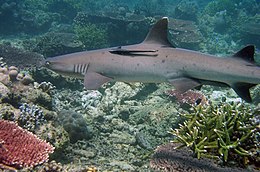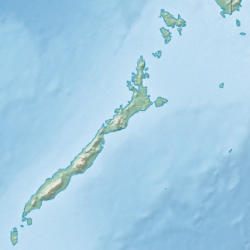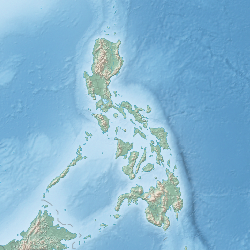Our website is made possible by displaying online advertisements to our visitors.
Please consider supporting us by disabling your ad blocker.
Tubbataha Reef
| UNESCO World Heritage Site | |
|---|---|
 Whitetip reef shark at Tubbataha | |
| Location | Cagayancillo, Palawan, Philippines |
| Criteria | Natural: (vii), (ix), (x) |
| Reference | 653bis |
| Inscription | 1993 (17th Session) |
| Extensions | 2009 |
| Area | 96,828 ha (239,270 acres) |
| Coordinates | 8°57′12″N 119°52′3″E / 8.95333°N 119.86750°E |
| Official name | Tubbataha Reefs Natural Park |
| Designated | November 12, 1999 |
| Reference no. | 1010[1] |
The Tubbataha Natural Park, also known as the Tubbataha Reefs Natural Park (Filipino: Bahurang Tubbataha), is a protected area of the Philippines located in the middle of the Sulu Sea. The marine and bird sanctuary consists of two huge atolls (named the North Atoll and South Atoll) and the smaller Jessie Beazley Reef covering a total area of 97,030 hectares (239,800 acres; 374.6 sq mi). It is located 150 kilometres (93 mi) southeast of Puerto Princesa, the capital of Palawan.[2] The uninhabited islands and reefs are part of the island municipality of Cagayancillo, located roughly 130 kilometers (81 mi) to the northeast of the reef.[2]
In December 1993, the UNESCO declared the Tubbataha Reefs National Park as a World Heritage Site as a unique example of an atoll reef with a very high density of marine species; the North Islet serving as a nesting site for birds and marine turtles. The site is an excellent example of a pristine coral reef with a spectacular 100-m perpendicular wall, extensive lagoons and two coral islands.[3] In 1999, Ramsar listed Tubbataha as one of the wetlands of international importance.[4] In 2008, the reef was nominated at New7Wonders of Nature.[5]
The national park and the rest of the Philippine archipelago is part of the Coral Triangle, recognized as a center of marine biodiversity containing 75% of the described coral species and 40% of the world's reef fish.[6] The area is under a grave threat due to overfishing and destructive fishing practices.[7] Research of scientists visiting the reefs since the 1980s revealed that the Tubbataha Reefs Natural Park contains no less than 600 fish species, 360 coral species, 11 shark species, 13 dolphin and whale species, and 100 bird species. The reefs also serve as a nesting ground for Hawksbill and Green sea turtles.
- ^ "Tubbataha Reefs Natural Park". Ramsar Sites Information Service. Retrieved April 25, 2018.
- ^ a b "Location of Tubbataha Reef". Tubbataha Reefs Natural Park. Archived from the original on March 12, 2020. Retrieved November 30, 2019.
- ^ "World Heritage List – Tubbataha Reefs Natural Park". UNESCO.
- ^ "Global and Ecological Significance of Tubbataha". Official Website of the Tubbataha Reefs National Park. Archived from the original on November 17, 2016. Retrieved February 11, 2013.
- ^ Aie Balagtas See (August 14, 2008). "4 RP bets in New 7 Wonders of Nature drop in rankings". GMA News. Retrieved February 6, 2013.
- ^ "The Coral Triangle". website. The Nature Convservancy. Archived from the original on October 28, 2016. Retrieved November 24, 2013.
- ^ Mnepornuc (August 5, 2009). "Saving the Coral Triangle". National Geographic Intelligent Travel. Retrieved on 2013-11-24.
Previous Page Next Page




